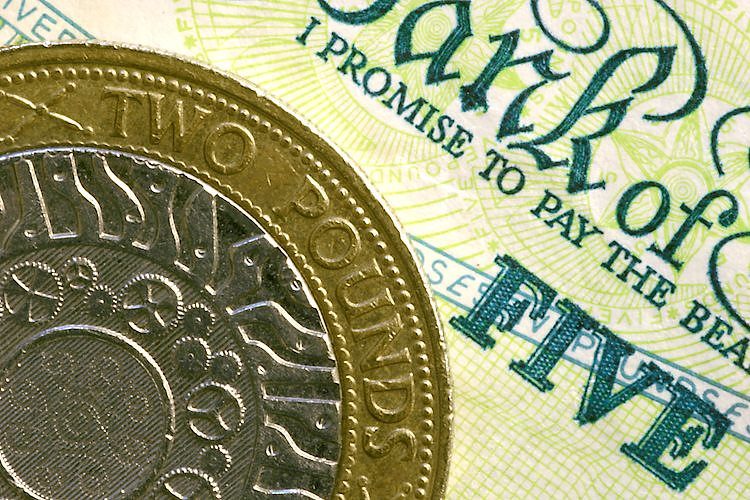Pound Sterling extends losing streak on firm BoE rate cut prospects
- The Pound Sterling faces selling pressure as the soft inflation outlook prompts BoE rate cut prospects.
- Weak UK Retail Sales also contribute to a softer inflation outlook.
- Fed’s higher for longer interest-rates argument strengthens the US Dollar.

The Pound Sterling (GBP) remains on the back foot in Monday’s early American session as investors continue to price in the Bank of England (BoE) will pivot to interest-rate cuts earlier than the US Federal Reserve (Fed). The GBP/USD pair trades close to a five-month low around 1.2360 as investors expect the Fed will keep its monetary policy framework restrictive for longer. A strong economic outlook and robust consumer spending in the United States are keeping inflation higher.
The US Dollar Index (DXY), which tracks the US Dollar’s value against six major currencies, trades broadly steady near the crucial support of 106.00. This week, the US Dollar will be guided by the core Personal Consumption Expenditure Price Index (PCE) data for March, which will influence Fed rate cut expectations. Currently, financial markets anticipate that the Fed will begin reducing borrowing rates in September.
Meanwhile, easing fears of further escalation in tensions between Israel and Iran could offer some support to risk-sensitive assets. Iran said they have no plans for an immediate retaliation, according to Al Jazeera.
Daily digest market movers: Pound Sterling weakens while US Dollar moves higher
- The Pound Sterling finds temporary support near 1.2360 after retreating from 1.2470. More downside remains likely after comments from Bank of England Deputy Governor Dave Ramsden on Friday, who said that upside risks to inflation have receded and that price growth could undershoot the central bank’s recent projections.
- Ramsden said "Over the last few months I have become more confident in the evidence that risks to persistence in domestic inflation pressures are receding, helped by improved inflation dynamics," Reuters reported. However, he warned that unlike the United States the backdrop to inflation in Britain was of continuing weak economic growth.
- Strong prospects for UK inflation easing sooner and a downbeat economic outlook are expected to allow the BoE to start reducing interest rates earlier than previously anticipated. Friday's dovish comments from BoE Deputy Governor Dave Ramsden echo through the market, and traders raise the probability of a June rate cut near 60%, Reuters reported.
- The prospects for inflation easing further were also boosted by weak Retail Sales data for March. The Office for National Statistics (ONS) showed Friday that Retail Sales were unchanged in March compared with the previous month and below the 0.3% increase forecast by economists. In February, Retail Sales grew by a meagre 0.1%. The Retail Sales data is a leading indicator of consumer spending, so weak figures signal the deepening cost-of-living crisis due to higher interest rates by the central bank.
- Going forward, the Pound Sterling will dance to the tunes of the S&P Global/CIPS preliminary PMI data for April, which will be published on Tuesday. The Manufacturing PMI is expected to expand steadily by 50.3. The Services PMI is estimated to have declined slightly to 53.0 from 53.1.
Technical Analysis: Pound Sterling drops to near 1.2300
The Pound Sterling resumes its downside journey after failing to recapture the crucial resistance of 1.2400. The GBP/USD pair weakens after a breakdown of the Head and Shoulder chart pattern, whose neckline is plotted from the December 8 low around 1.2500. Declining 20-day and 50-day Exponential Moving Averages (EMAs) at 1.2525 and 1.2600, respectively, indicate that the long-term outlook is bearish.
The 14-period Relative Strength Index (RSI) oscillates in the range of 20.00-40.00, indicating a strong bearish momentum.
BoE FAQs
The Bank of England (BoE) decides monetary policy for the United Kingdom. Its primary goal is to achieve ‘price stability’, or a steady inflation rate of 2%. Its tool for achieving this is via the adjustment of base lending rates. The BoE sets the rate at which it lends to commercial banks and banks lend to each other, determining the level of interest rates in the economy overall. This also impacts the value of the Pound Sterling (GBP).
When inflation is above the Bank of England’s target it responds by raising interest rates, making it more expensive for people and businesses to access credit. This is positive for the Pound Sterling because higher interest rates make the UK a more attractive place for global investors to park their money. When inflation falls below target, it is a sign economic growth is slowing, and the BoE will consider lowering interest rates to cheapen credit in the hope businesses will borrow to invest in growth-generating projects – a negative for the Pound Sterling.
In extreme situations, the Bank of England can enact a policy called Quantitative Easing (QE). QE is the process by which the BoE substantially increases the flow of credit in a stuck financial system. QE is a last resort policy when lowering interest rates will not achieve the necessary result. The process of QE involves the BoE printing money to buy assets – usually government or AAA-rated corporate bonds – from banks and other financial institutions. QE usually results in a weaker Pound Sterling.
Quantitative tightening (QT) is the reverse of QE, enacted when the economy is strengthening and inflation starts rising. Whilst in QE the Bank of England (BoE) purchases government and corporate bonds from financial institutions to encourage them to lend; in QT, the BoE stops buying more bonds, and stops reinvesting the principal maturing on the bonds it already holds. It is usually positive for the Pound Sterling.
Author

Sagar Dua
FXStreet
Sagar Dua is associated with the financial markets from his college days. Along with pursuing post-graduation in Commerce in 2014, he started his markets training with chart analysis.


















